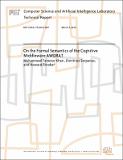On the Formal Semantics of the Cognitive Middleware AWDRAT
Author(s)
AIRE; Khan, Muhammad Taimoor; Serpanos, Dimitrios; Shrobe, Howard
DownloadMIT-CSAIL-TR-2015-007.pdf (397.8Kb)
Other Contributors
Cybersecurity
Advisor
Howard Shrobe
Metadata
Show full item recordAbstract
The purpose of this work is two fold: on one hand we want to formalize the behavior of critical components of the self generating and adapting cognitive middleware AWDRAT such that the formalism not only helps to understand the semantics and technical details of the middleware but also opens an opportunity to extend the middleware to support other complex application domains of cybersecurity; on the other hand, the formalism serves as a prerequisite for our proof of the behavioral correctness of the critical components to ensure the safety of the middleware itself. However, here we focus only on the core and critical component of the middleware, i.e. Execution Monitor which is a part of the module "Architectural Differencer" of AWDRAT. The role of the execution monitor is to identify inconsistencies between run-time observations of the target system and predictions of the System Architectural Model. Therefore, to achieve this goal, we first define the formal (denotational) semantics of the observations (run-time events) and predictions (executable specifications as of System Architectural Model); then based on the aforementioned formal semantics, we formalize the behavior of the "Execution Monitor" of the middleware.
Date issued
2015-03-03Series/Report no.
MIT-CSAIL-TR-2015-007
Keywords
cyber-security, reference-monitor, wrappers, executable specification
